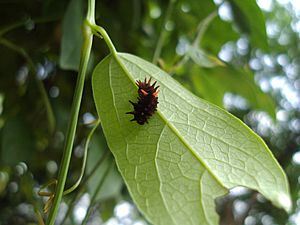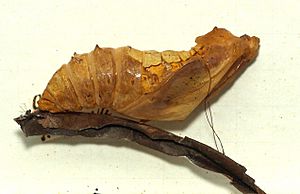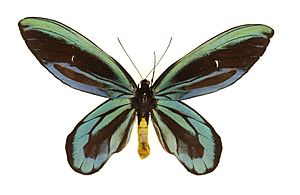Birdwing facts for kids
Quick facts for kids Birdwings |
|
|---|---|
 |
|
| Male (left) and female (right) representatives of Trogonoptera (top), Troides (middle), and Ornithoptera (bottom) | |
| Scientific classification | |
| Kingdom: | Animalia |
| Phylum: | Arthropoda |
| Class: | Insecta |
| Order: | Lepidoptera |
| Family: | Papilionidae |
| Subfamily: | Papilioninae |
| Tribe: | Troidini |
| Genera | |
|
|
Birdwings are a special group of butterflies in the swallowtail family. They belong to three main groups, called genera: Trogonoptera, Troides, and Ornithoptera. There are about 36 different kinds of birdwings known today.
These butterflies are named "birdwings" because they are super big! They also have unique, angled wings and fly like birds. You can find them in warm, tropical parts of Asia, including Southeast Asia, and also in Australasia.
Some of the biggest butterflies in the world are birdwings. The Queen Alexandra's birdwing is the largest of all. The Goliath birdwing is the second largest. Australia's biggest butterfly, the Cairns birdwing, is also a birdwing. India's largest butterfly, the southern birdwing, is another one. You might also know Rajah Brooke's birdwing, which is very beautiful. It was named after Sir James Brooke, a famous ruler in the 1800s.
Because they are so large and the males are often brightly colored, many people like to collect them. However, all birdwings are now protected by an agreement called CITES. This means that buying and selling them across countries is limited. For the Queen Alexandra's birdwing, it's completely against the law to trade them internationally.
Contents
Life Cycle of Birdwings
Birdwings go through four main stages in their life, just like many other butterflies. These stages are egg, larva (caterpillar), pupa (chrysalis), and adult.
Eggs (Ova)
After a female birdwing mates, she immediately starts looking for the right plants to lay her eggs on. She only chooses climbing vines from the Aristolochia and Pararistolochia families. The female lays her round eggs one by one, usually under the tips of the vine's leaves.
Caterpillars (Larva)
Birdwing caterpillars are very hungry! They eat a lot but don't move much. A small group of them can eat all the leaves off a vine. If there are too many caterpillars and not enough food, they might even start eating each other.
These caterpillars have soft, spine-like bumps on their backs. Their bodies are dark red, brown, or velvety black. Some species have bright red bumps or pale "saddle" marks. Like other swallowtail caterpillars, they have a special organ behind their heads called an osmeterium. It looks like a snake's forked tongue. When the caterpillar feels threatened, it sticks out this organ and releases a bad-smelling liquid.
Birdwing caterpillars are also poisonous to most predators. The vines they eat contain a toxic substance called aristolochic acid. The caterpillars absorb this poison into their bodies. The poison stays with them through their metamorphosis and even into their adult butterfly stage.
Chrysalis (Pupa)
The chrysalids (or pupae) of birdwings are camouflaged. They look like a dead leaf or a small twig, which helps them hide from predators. Before turning into a chrysalis, the caterpillars might travel far from their food plants. For example, the Queen Alexandra's birdwing takes about four months to grow from an egg to an adult butterfly. As adults, they can live for up to three months if they avoid being eaten.
Adult Butterflies (Imago)
Adult birdwings live in rainforests. You often see them flying along the edges of the forest. They drink nectar from flowers, both high up in the trees and on the ground. They are important pollinators, helping plants reproduce. Birdwings are strong flyers and love to rest in sunny spots to warm up.
Birdwings are known for their large size. Some can have a body length of up to 7.6 centimeters (3 inches) and a wingspan of 28 centimeters (11 inches), like the Queen Alexandra's birdwing. They have bright colors, often green, yellow, black, white, and sometimes blue or orange. Their front wings are long and pointed. Most birdwings do not have tails on their hindwings.
In Ornithoptera species, males and females look very different. Males are usually black with shiny green, blue, orange, or yellow colors. Females are larger and less colorful, mostly black or dark brown with white, pale brown, or yellow marks. This difference helps them recognize each own species.
Most Troides birdwings have similar males and females. They are usually jet black or brown on their front wings. The veins on their wings are often outlined in grey or creamy white. Some Troides species have special parts on their wings and antennae that can sense temperature changes. This helps them control their body temperature and avoid getting too hot when they are basking in the sun.
Some birdwings, like Troides magellanus, have a special kind of shine on their wings. Their yellow hindwings can look bright blue-green, but only if you look at them from a certain angle. This "grazing iridescence" happens because of how light bounces off their tiny wing scales.
It's interesting to know that Troides and Ornithoptera butterflies are very closely related. In fact, people who breed butterflies have even created hybrids by crossing these two groups.
The smallest group of birdwings is Trogonoptera, with only two species. They look similar, being mostly black with shiny green markings and a red head. The females are not as bright as the males.
Where Birdwings Live (Distribution)
Birdwings are generally found from Southeast Asia all the way to northern Australasia. For example, Trogonoptera brookiana lives in the Malay Peninsula, Borneo, Sumatra, and nearby islands. Trogonoptera trojana is only found on Palawan in the Philippines.
Troides species are found across a wide area of Asia, reaching as far east as New Guinea. Some species can even be found as far west as India, making them the westernmost birdwings. All Ornithoptera species live in the northern part of Australasia, including the Maluku Islands, New Guinea, the Solomon Islands, and northeastern Australia. One species, the Richmond birdwing, can be found in far northeastern New South Wales, Australia. This is the southernmost place where any birdwing lives.
Protecting Birdwings (Status and Protection)
Most birdwings are listed under Appendix II of CITES. This means that trading them across international borders is controlled. However, there are exceptions for butterflies that are raised in special farms, mostly in Papua New Guinea and Indonesia. Many species from all three groups have been successfully raised in captivity.
The Queen Alexandra's birdwing (O. alexandrae) is listed on Appendix I. This means it is completely illegal to trade this species internationally. Some experts have suggested moving it to Appendix II, thinking that allowing some controlled trade might help its conservation more.
Some birdwing species have also been checked by the IUCN Red List, which assesses how endangered species are. Their status ranges from "least concern" (meaning they are not currently at risk) to "endangered" (meaning they are at high risk of disappearing).
The Richmond birdwing (O. richmondia) needs a specific plant called Aristolochia praevenosa for its caterpillars to eat. However, a very similar plant, Aristolochia elegans (also known as Dutchman's pipe), is often found in Australian gardens. This plant is poisonous to the Richmond birdwing caterpillars and can kill them.
Reproduction of Birdwings
Ornithoptera birdwing butterflies usually reproduce sexually, and they lay eggs.
Female Choice
Female butterflies can be picky about who they mate with. This "female choice" is very important for successful reproduction. Sometimes, if females of certain Ornithoptera species cannot find a male of their own kind, they might mate with a different species. For example, Troides oblongamaculatus females have been known to choose to mate with Ornithoptera priamus poseidon males if their own species is not nearby. This can lead to hybrid offspring.
Male Courtship
Male Ornithoptera species have special ways of trying to attract a female. For instance, Ornithoptera priamus poseidon males will carefully approach a female and watch her for a few minutes. Then, the male might hover about 20 to 30 centimeters (8 to 12 inches) above her. While hovering, he shows off the bright yellow markings on his hindwings. His front wings move forward, showing his body and special hair tufts. Mating only happens when the female stops flapping her wings, which signals she is ready.
Sexual Dimorphism
Sexual dimorphism means that males and females of a species look very different. This is very clear in Ornithoptera species. The males are black with bright blue, green, orange, or yellow colors. The females are generally larger and are mostly black or dark brown. These color differences help the butterflies recognize their own species when looking for a mate.
See also




